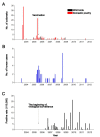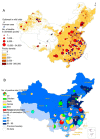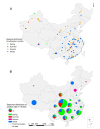Highly Pathogenic Avian Influenza H5N1 in Mainland China
- PMID: 26006118
- PMCID: PMC4454952
- DOI: 10.3390/ijerph120505026
Highly Pathogenic Avian Influenza H5N1 in Mainland China
Abstract
Highly pathogenic avian influenza (HPAI) H5N1 has posed a significant threat to both humans and birds, and it has spanned large geographic areas and various ecological systems throughout Asia, Europe and Africa, but especially in mainland China. Great efforts in control and prevention of the disease, including universal vaccination campaigns in poultry and active serological and virological surveillance, have been undertaken in mainland China since the beginning of 2006. In this study, we aim to characterize the spatial and temporal patterns of HPAI H5N1, and identify influencing factors favoring the occurrence of HPAI H5N1 outbreaks in poultry in mainland China. Our study shows that HPAI H5N1 outbreaks took place sporadically after vaccination campaigns in poultry, and mostly occurred in the cold season. The positive tests in routine virological surveillance of HPAI H5N1 virus in chicken, duck, goose as well as environmental samples were mapped to display the potential risk distribution of the virus. Southern China had a higher positive rate than northern China, and positive samples were mostly detected from chickens in the north, while the majority were from duck in the south, and a negative correlation with monthly vaccination rates in domestic poultry was found (R = -0.19, p value = 0.005). Multivariate panel logistic regression identified vaccination rate, interaction between distance to the nearest city and national highway, interaction between distance to the nearest lake and wetland, and density of human population, as well as the autoregressive term in space and time as independent risk factors in the occurrence of HPAI H5N1 outbreaks, based on which a predicted risk map of the disease was derived. Our findings could provide new understanding of the distribution and transmission of HPAI H5N1 in mainland China and could be used to inform targeted surveillance and control efforts in both human and poultry populations to reduce the risk of future infections.
Keywords: China; GIS; H5N1; highly pathogenic avian influenza; public health; risk prediction.
Figures




Similar articles
-
Spatial distribution and risk factors of highly pathogenic avian influenza (HPAI) H5N1 in China.PLoS Pathog. 2011 Mar;7(3):e1001308. doi: 10.1371/journal.ppat.1001308. Epub 2011 Mar 3. PLoS Pathog. 2011. PMID: 21408202 Free PMC article.
-
Environmental factors contributing to the spread of H5N1 avian influenza in mainland China.PLoS One. 2008 May 28;3(5):e2268. doi: 10.1371/journal.pone.0002268. PLoS One. 2008. PMID: 18509468 Free PMC article.
-
Flying over an infected landscape: distribution of highly pathogenic avian influenza H5N1 risk in South Asia and satellite tracking of wild waterfowl.Ecohealth. 2010 Dec;7(4):448-58. doi: 10.1007/s10393-010-0672-8. Epub 2011 Jan 26. Ecohealth. 2010. PMID: 21267626 Free PMC article.
-
Vaccination of domestic ducks against H5N1 HPAI: a review.Virus Res. 2013 Dec 5;178(1):21-34. doi: 10.1016/j.virusres.2013.07.012. Epub 2013 Aug 3. Virus Res. 2013. PMID: 23916865 Review.
-
Origin and evolution of highly pathogenic H5N1 avian influenza in Asia.Vet Rec. 2005 Aug 6;157(6):159-64. doi: 10.1136/vr.157.6.159. Vet Rec. 2005. PMID: 16085721 Review.
Cited by
-
Risk Distribution of Human Infections with Avian Influenza H7N9 and H5N1 virus in China.Sci Rep. 2015 Dec 22;5:18610. doi: 10.1038/srep18610. Sci Rep. 2015. PMID: 26691585 Free PMC article.
-
H7N9 and H5N1 avian influenza suitability models for China: accounting for new poultry and live-poultry markets distribution data.Stoch Environ Res Risk Assess. 2017;31(2):393-402. doi: 10.1007/s00477-016-1362-z. Epub 2016 Dec 5. Stoch Environ Res Risk Assess. 2017. PMID: 28298880 Free PMC article.
-
Environmental factors and spatiotemporal distribution characteristics of the global outbreaks of the highly pathogenic avian influenza H5N1.Environ Sci Pollut Res Int. 2022 Jun;29(29):44175-44185. doi: 10.1007/s11356-022-19016-1. Epub 2022 Feb 6. Environ Sci Pollut Res Int. 2022. PMID: 35128608 Free PMC article.
-
Smartphone-Based Fluorescent Diagnostic System for Highly Pathogenic H5N1 Viruses.Theranostics. 2016 Jan 1;6(2):231-42. doi: 10.7150/thno.14023. eCollection 2016. Theranostics. 2016. PMID: 26877781 Free PMC article.
-
Preliminary Epidemiologic Assessment of Human Infections With Highly Pathogenic Avian Influenza A(H5N6) Virus, China.Clin Infect Dis. 2017 Aug 1;65(3):383-388. doi: 10.1093/cid/cix334. Clin Infect Dis. 2017. PMID: 28407105 Free PMC article.
References
-
- OIE Avian Influenza Portal. [(accessed on 1 October 2014)]. Available online: http://www.oie.int/animal-health-in-the-world/web-portal-on-avian-influenza.
-
- WHO H5N1 influenza. [(accessed on 1 October 2014)]. Available online: http://www.who.int/influenza/human_ animal_interface/avian_influenza/h5n...
Publication types
MeSH terms
LinkOut - more resources
Full Text Sources
Other Literature Sources
Medical

